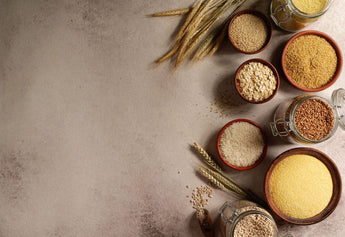A2 Badri cow ghee from Uttarakhand represents the idea of mindful consumerism and living sustainably, reflecting a direct connection from the farm to your table. Sourced locally, it echoes the pureness of fresh natural ghee, blending smoothly with a diet focused on plants and organic food. Prepared with environmentally friendly methods, this treat surpasses usual ghee products.
It follows the ideas of thoughtful preparation, making healthy choices and sticking to the belief of creating goods without harming animals. In the idea of living in a way that helps the environment, A2 Cow Ghee makes cooking more enjoyable with its creamy texture, being a useful addition to natural recipes. It becomes a sign of ‘desi’ purity, representing the journey from the farm to the kitchen that connects with people living a holistic lifestyle.
Why are Badri Cows Special?
Kamdhenu, or Surabhi, is the mother of all cows in Hindu mythology. Kamdhenu is thought to be a special cow goddess known as Gou Mata (The Mother of all cows) in Hinduism. We could say that the Badri cow of Uttarakhand is like the modern-day Kamdhenu. This comparison is drawn from both scientific nutraceutical information and spiritual beliefs surrounding the Badri cow.
Alt text: Badri Cow, A2 Badri Cow Ghee
The Badri cow is an indigenous breed of Uttarakhand mainly found in the state's steep terrain. These cows are tiny, weighing between 200 and 250 kg on average. The cows' necks are wide and small, and their eyes are bright and attentive. The animal's ears are usually upright and demonstrate its vigilance. The udder is less developed, with an average of 1.0-3.0 kg milk output per cow daily. Small, straight legs with a firm footpad and hooves allow these cows to navigate the heights and valleys of steep terrain readily. The Red Badri cow is a dual-purpose desi breed for milking and rituals. The Badri cow is considered fortunate cattle and has been used for religious purposes for centuries. Badri cows usually feed on natural vegetation and dwell in Uttarakhand highland areas' natural, pollution-free environment.
Benefits of Badri Cow Ghee
Research conducted on the milk of the Badri cow by scientists of UCOST (Uttarakhand State Council of Science and Technology) and IIT (Indian Institute of Technology) Roorkee has revealed the fact that the milk of the Badri cow is the best in the world. This milk is the most beneficial and healthy. Badri cows provide high-quality milk. It is due to their diet from mountains containing various medicinal plants and herbs, shrubs and other fodder species. It is in great demand not only in the country but also abroad. Let us know its benefits:
- This breed's milk is yellow, easy to digest, and has therapeutic potential. The Badri cow's milk contains about 90% A2 beta-casein proteins, the highest of any indigenous cow kind.
- This ghee is made using the old Bilona method due to which its medicinal properties do not get destroyed.
- Badri cows, native to the Himalayas, produce milk with superior immune-modulating properties compared to other breeds, making it highly beneficial for cancer patients.
- These cows are well adapted to mountainous regions, can withstand sub zero temperatures, and have never fallen sick due to cold shocks.
- Badri cow ghee meets the dietary and nutritional needs of all age groups, including infants and older individuals, and is easily digested even by those with lactose intolerance and casein allergy.
- Badri cow ghee is rich in antioxidants, butyric acid, omega-3 fatty acids, and conjugated linoleic acid (CLA), which have various health benefits including boosting immunity, fighting allergens, protecting against diseases like diabetes, and exhibiting anti-cancer properties.
- Vitamin K2 present in Badri cow ghee contributes to bone density maintenance and healthy teeth, while vitamins A and E support overall body growth.
- Badri cow ghee also possesses anti-inflammatory properties and is known for its therapeutic benefits.
Why is Cow Ghee important to us?
There's something special about the golden colour and smell of fresh ghee sitting on our kitchen counter. We all love the nutty aroma when it's made using the traditional hand-churning method (Bilona Method), just like our ancestors did in villages. According to Ayurveda, eating ghee has many benefits:
- Ghee helps your mind stay clear and your digestion runs smoothly. The Charaka Samhita, an Ayurvedic text, recommends ghee for people with Vata and Pitta body types. Those with imbalances of Vata and Pitta, want good eyesight, and seek overall health benefits should consume ghee on a daily basis.
- Ghee is said to promote clear skin, a strong voice, better nourishment, vitality, memory, intelligence, good digestion, and proper sensory function. It's also helpful for healing burns.
- It's also good for the elderly, kids, individuals, and those seeking better health, clear skin, and a strong body.
- Ghee can improve vitality, memory, intelligence, digestion, and sensory organs, and help heal burns.
Pahadi Cow Ghee is believed to support overall well-being and energy levels.



